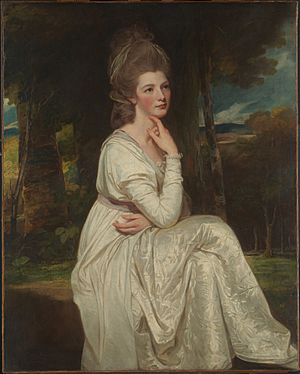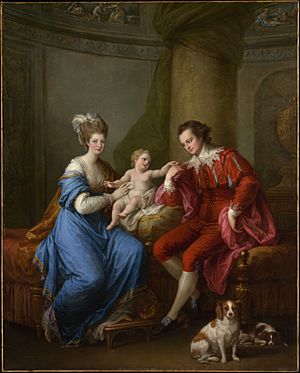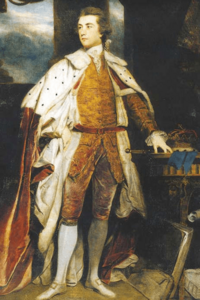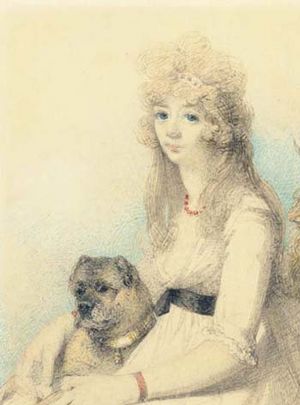Elizabeth Smith-Stanley, Countess of Derby facts for kids
Quick facts for kids
Elizabeth Hamilton
|
|
|---|---|
| Countess of Derby | |

The Countess of Derby; George Romney, c. 1776–78
|
|
| Born | 26 January 1753 |
| Died | 14 March 1797 (aged 44) |
| Spouse(s) | Edward Smith-Stanley, 12th Earl of Derby |
| Issue | Edward Smith-Stanley, 13th Earl of Derby Lady Charlotte Hornby Lady Elizabeth Henrietta Cole |
| Father | James Hamilton, 6th Duke of Hamilton |
| Mother | Elizabeth Gunning, 1st Baroness Hamilton of Hameldon |
Elizabeth Smith-Stanley, Countess of Derby (born Elizabeth Hamilton; 26 January 1753 – 14 March 1797) was an important English noblewoman. She was the eldest daughter of the 6th Duke of Hamilton. In 1774, she married Edward Smith-Stanley, the 12th Earl of Derby. They had three children together.
Lady Derby was very popular in society. She was known for organizing a special cricket match for ladies. She was also a trendsetter in fashion, much like the famous Duchess of Devonshire.
Later, Lady Derby separated from her husband. This caused a big stir in society. She moved abroad for a time. She returned to England when her husband's new relationship with actress Elizabeth Farren became very public. He married Elizabeth Farren after Lady Derby passed away in 1797.
Contents
Early Life and Family Background
Lady Elizabeth Hamilton was born on 26 January 1753. She was the first child of James Hamilton, 6th Duke of Hamilton and Elizabeth Gunning. She had two younger brothers. Her father died in 1758.
Her mother, the Duchess of Hamilton, was known as one of the most beautiful women of her time. In 1759, she remarried John Campbell. This marriage gave Lady Elizabeth three younger half-brothers and two younger half-sisters.
Marriage and Social Life

When Lady Elizabeth, also called Betty, had her first social season in London, she was considered a very good match for marriage. Many young noblemen were interested in her. In 1773, Edward Smith-Stanley, who was very wealthy, began to pursue her. He held a grand party just for her.
The next year, while they were engaged, he threw an even more amazing party. The young couple dressed in costumes from the time of artist Anthony van Dyck. On 23 June 1774, they were married. The playwright John Burgoyne hosted a "glittering" party after the wedding. He even wrote a play called The Maid of the Oaks to celebrate their marriage. This huge event featured dancers, acrobats, and famous opera singers. The grand finale was a pretend wedding with nymphs, where Lady Elizabeth was presented at an altar.
Elizabeth quickly had a son and two daughters. In 1776, her husband became the Earl of Derby. This meant Elizabeth became the Countess of Derby. With her new important title, Lady Derby was very popular among the fashionable society. Her actions often appeared in the newspapers. She was seen as a leader in fashion, alongside the Duchess of Devonshire. In 1777, she organized a cricket match where the teams were made up of upper-class women. This was quite unusual for that time.
Around 1776, a family painting was created by Angelica Kauffman. Lady Derby's mother likely asked for this painting. Kauffman painted two versions of a portrait showing the Earl, Countess, and their son. One is at the Metropolitan Museum of Art, and the other is still with the family's descendants. Between 1776 and 1778, George Romney also painted Lady Derby. This painting is now in the National Portrait Gallery.
Separation and Return to Society

By May 1778, rumors about Lady Derby and the 3rd Duke of Dorset began to appear in the newspapers. To try and stop the gossip, Lady Derby's mother went with her daughter to the theater. However, by August 1778, the Countess was living separately from her husband in the countryside. People were gossiping that she was seeking a divorce.
Her separation from her husband caused a big stir in society. She was often left out of social events. At first, many people thought she and the Duke of Dorset would marry. This made some people hesitate to ignore her, in case she returned with an even higher social standing. Lady Derby stayed in the countryside while her husband seemed to ignore the situation.
However, over a year after they separated, the Earl of Derby announced he would not divorce his wife. This meant Lady Derby could not remarry. Her hopes of returning to society as a duchess were gone. Her children stayed with the Earl. Lady Derby avoided London society and lived abroad until 1783. Her family tried to convince the Earl to make up with his wife.
During this time, Lord Derby started a very public relationship with the actress Elizabeth Farren. From 1781 onwards, their relationship was often shown in funny newspaper drawings. Amidst this attention, Lady Derby quietly returned to London. She slowly started appearing at events again. She later moved in with her brother, the 8th Duke of Hamilton. By 1784, she was accepted in society enough to be seen with the Duchess of Devonshire again.
No reconciliation ever happened between Lady Derby and her husband. The Earl and Elizabeth Farren waited for Lady Derby's death so he could remarry. The Countess of Derby died on 14 March 1797 from tuberculosis. Her husband married Elizabeth Farren less than two months later, after Farren stopped acting.
Children of Lady Derby

Lady Derby had three children:
- Edward Smith-Stanley, 13th Earl of Derby (born 21 April 1775 – died 30 June 1851). He married his cousin, Charlotte Margaret Hornby.
- Lady Charlotte (born 17 October 1776 – died 25 November 1805). She married her cousin, Edmund Hornby.
- Lady Elizabeth Henrietta (born 29 April 1778 – died around 1857). She married Thomas Cole.
Even though there were rumors about the third child, Lady Elizabeth Henrietta, the Earl of Derby cared for her after his wife left him.


